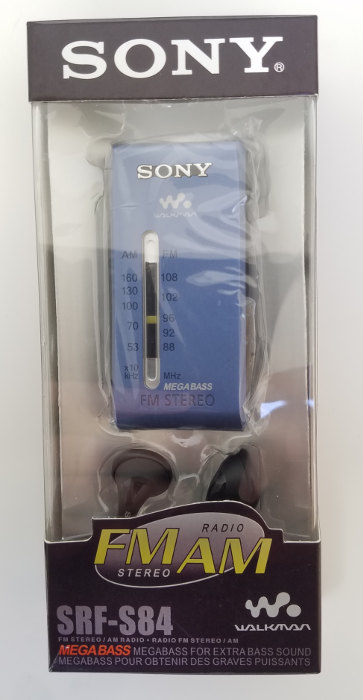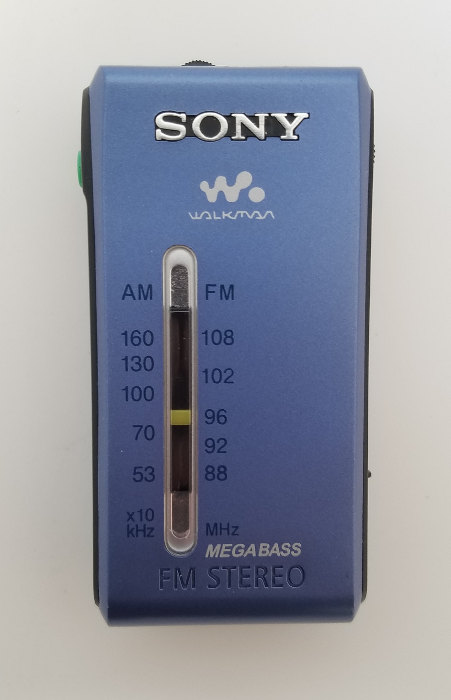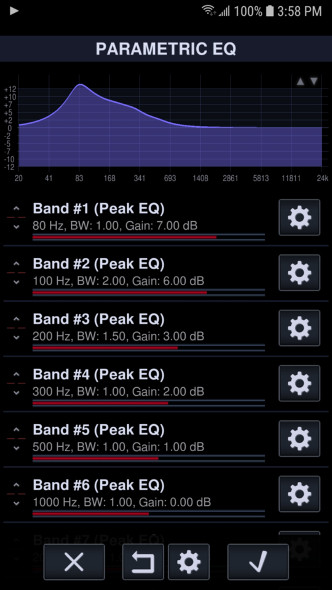Radios I Have Known
Sony SRF-S84 AM/FM Walkman radio


While this radio is branded with the Walkman name, I've decided to give the Sony SRF-S84 its own review. It's a more recent radio than most of the others I've covered in the article on Sony Walkman radios, it's tiny, and it has one notable and very useful feature that older Walkman radios didn't have.
The photos above may not give a good sense of how tiny this radio really is. It's just 3 inches high by an inch and a half wide and a half-inch thick. It runs on a single AAA battery. Yet it includes both AM and FM reception as well as a standard-sized 3.5 mm stereo headphone jack. The instruction manual for the radio is bigger than the radio itself!
The auction sites had this radio available for around $40 to $50 in 2020. Retail prices circa 2015 were around $35.
There are multiple versions. At least two colors are available, a silvery gold color and a metallic blue. There's also a version for the Japanese market, with reception for both the Japanese FM band from 76 to 90 MHz and the 87.5 (or 88) to 108 MHz band used in most of the rest of the world. As you can see from the photos, the radio that I have doesn't include coverage of most of the Japanese FM band.
Performance is fairly pedestrian. It's adequate for local AM and FM signals. The SRF-S84 is neither particularly sensitive or selective. An AM receiver this small is going to be limited anyway; FM performance is further limited by the use of the headphone cord as the antenna, typical for this type of radio.
The SWLing Post notes that the radio uses a Sony custom integrated-circuit chip, the CXA1129N, which is used in other Sony portables. That blog notes that the radio has very good audio quality, but more about that after briefly covering a few of the radio's controls.
There is the option to force monaural reception on FM, which can make a noisy signal more listenable. The AM section of this receiver also seems to have a very high noise floor, sounding almost as if FM reception is leaking into the AM section.
The controls are small and stiff. They're hard to maneuver, especially the tuning thumbwheel.
There is one thing the radio does spectacularly well. There is a switch to activate its "megabass" circuitry, to boost bass frequencies when listening through earbuds. It really works. I used Apple EarPods with this unit and found that, with the megabass circuit in use, they sounded nearly as rich in lower frequencies as good over-the-ear headphones.
I ran frequency sweeps, using a small flea-powered FM transmitter, with megabass off and with it on. The megabass circuit starts boosting the sound just above 500 Hz, rising 3 dB at 200 Hz and 7 dB at 100 Hz. Unfortunately, the program I use to generate response curves stops sampling at just under 100 Hz, but I suspect the bass boost continues fairly sharply upward to at least 50 Hz.

I attempted replicate this effect on my mobile devices, using the parametric equalizer in my favorite music player, Neutron MP (an Android app). I had some difficulties at first because the Neutron MP equalizer is very flexible, which also means it can be quite complex. After some experimentation, I was able to come up with a reasonable approximation, as shown at left.
This approximation still has some challenges. For relatively loud music files, there is quite a bit of distortion at the lower end, which is not a problem with the SRF-S84. The distortion may be due to the relatively weak headphone outputs on many phones and tablets. I have been moderately dissatisfied with those outputs. The SRF-S84 probably has a far better match between its "megabass" equalization curve and its headphone output. It has a better amplifier than many phones and tables.
Neutron MP has a dynamic range compressor and limiter, which solves the distortion problem but which also creates another one. Since it's a single-band compressor, some very undesirable effects can occur, causing what's perceived as a loss of higher frequencies whenever bass notes are dominant in the program material. So the "megabass" feature is a tricky one to emulate.
In summary, the small size of the SRF-S84 is very handy, the unit is well-made (as you would expect from Sony), and, in the right circumstances, the megabass function makes earbuds sound much better than they would otherwise. If you keep its other performance limitations in mind, the SRF-S84 is a convenient, pleasant radio for local FM reception during outdoor activities, which is probably its intended purpose. For a general-purpose radio, there are far better choices.